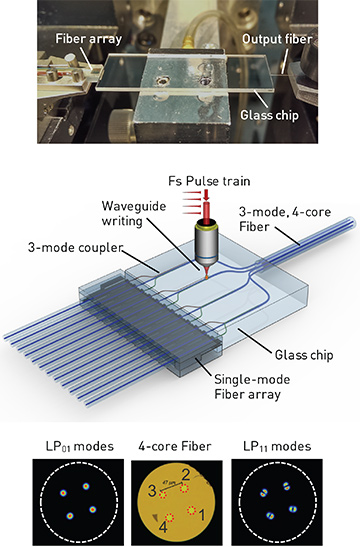 Photograph (top) and schematic (middle) of ultrafast laser-written multiplexer, which can selectively address individual modes of a multimode, multicore fiber—for example, 3-mode, 4-core fiber, as shown here (bottom).
Photograph (top) and schematic (middle) of ultrafast laser-written multiplexer, which can selectively address individual modes of a multimode, multicore fiber—for example, 3-mode, 4-core fiber, as shown here (bottom).
Optical fiber forms the backbone of global internet communications. At present, more than three million terabytes of internet traffic passes through optical fibers every day, and the total data demand could triple by 2021, driven by the basic human desire to communicate.1
Sustaining that growth will require new techniques for increasing fiber capacity as the limits of currently deployed single-mode optical fiber are reached. One such technique is space-division multiplexing,2–5 in which different data channels within the cross section of an optical fiber are used to increase capacity. This can involve multicore fiber, few-mode fiber, or a combination of both. Addressing the individual modes of such fibers, however, has until recently not been possible with compact integrated technologies.
In 2017, we demonstrated successful fabrication of advanced integrated multiplexers that can be used in space-division multiplexing for selectively addressing the individual cores and modes of fibers.4 In the fabrication technique used, ultrafast laser inscription, laser pulses induce permanent refractive-index changes inside glass chips. Translating the glass chip through the focus of the laser beam allows waveguides to be produced in three dimensions.
Access to the third dimension for fabrication is particularly important for multiplexing the modes and cores of optical fibers. The devices we have fabricated inside boroaluminosilicate glass chips include a compact mode multiplexer capable of addressing the 12 individual modes of a three-mode, four-core fiber with 20-dB mode extinction ratio and 1.8-dB insertion loss, on average, over the S+C+L bands.4 These compact integrated devices substitute for the lossy, bulky free-space optics often used for exciting the individual modes of closely spaced cores of such fibers.
By scaling to more cores and more modes, multimode, multicore fibers have the potential to allow for a two-order-of-magnitude increase in optical fiber capacity.4 Other devices we have previously realized include mode multiplexers capable of operating at the erbium-doped fiber amplifier pump bands.5 These devices could allow for mode amplification in long-haul networks. Compact ultrafast laser-written devices such as these offer a potentially significant technology in the pursuit of practical space-division multiplexing for increasing internet data speeds.
Researchers
Nicolas Riesen, Simon Gross and Michael J. Withford, University of South Australia, Adelaide, Australia, Macquarie University, Sydney, Australia, and Modular Photonics Pty Ltd, Sydney, Australia
References
1. CISCO Visual Networking Index: Forecast and Methodology, 2016-2021.
2. D.J. Richardson et al. Nat. Photon. 7, 354 (2016).
3. R.G.H. van Uden et al. Nat. Photon. 8, 865 (2014).
4. N. Riesen et al. Sci. Rep. 7, 6971 (2017).
5. S. Gross et al. Laser Photon. Rev. 8, L81 (2014).
